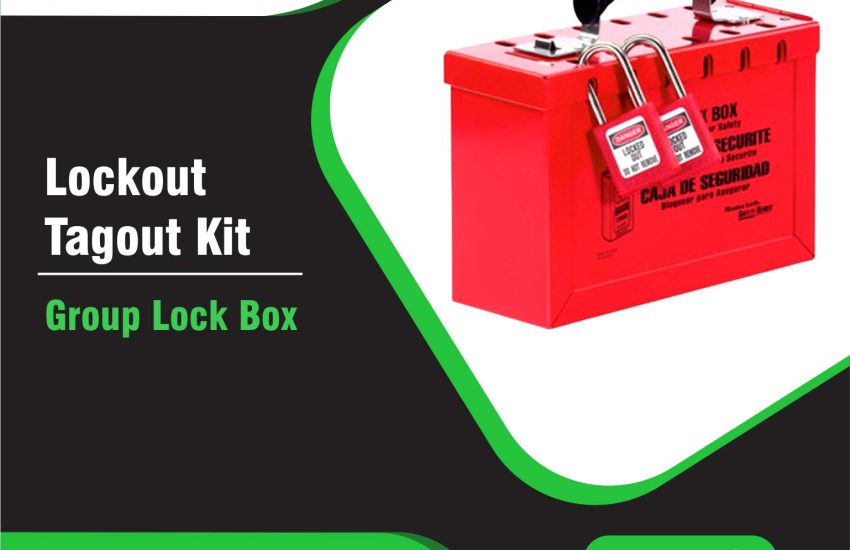A Metal Group Lock Box plays a vital role in lockout/tagout (LOTO) procedures, ensuring the safety of workers during maintenance and equipment repairs. These lock boxes offer a secure method for multiple workers to lock out a single energy source. They prevent accidental startups, reduce the risk of injury, and promote a safe work environment. In this article, we will explore the Metal Group Lock Box’s specifications, benefits, and why it’s essential for workplace safety.
What is a Metal Group Lock Box?
A Group Lock Box stores multiple locks used by workers during lockout/tagout procedures. It ensures that every worker involved in a maintenance task can lock out an energy source while keeping the process organized and secure. The box has several compartments or hooks where workers can attach their personal locks. One padlock secures the box until all workers have removed their locks. Once this is done, the equipment can be safely operated again.
Why is a Metal Group Lock Box Important?
A Group Lock Box is critical when multiple workers need to work on the same piece of machinery or equipment. It allows each worker to lock out energy sources, preventing unauthorized individuals from restarting the machine. This promotes safety, minimizes the risk of accidents, and ensures compliance with OSHA lockout/tagout regulations.
Key benefits include:
- Enhanced Worker Safety: Each worker controls the energy source, reducing the risk of accidental energy release.
- Organized Lockout/Tagout Process: The box serves as a central storage location for locks, streamlining the lockout/tagout procedure.
- Compliance with Safety Regulations: It helps organizations meet regulatory standards, like those from OSHA.
Specifications of a Metal Group Lock Box
The specifications of a Metal Group Lock Box can vary, but common features include:
- Material Construction: These boxes are typically made from durable steel. Steel resists wear, corrosion, and impact, making it ideal for harsh industrial environments.
- Locking Mechanism: The lock box features a heavy-duty latch or padlock system. The padlock keeps the box securely closed until all workers have removed their individual locks.
- Capacity: A Metal Group Lock Box can hold anywhere from 6 to 30 or more locks, depending on the size of the lockout team and the equipment involved. Larger boxes are ideal for workplaces with numerous maintenance workers.
- Compartmentalized Design: Many lock boxes have compartments or hooks for organizing each worker’s lock. This design ensures the equipment remains securely locked and that each lock is easily identifiable.
- Portability and Mounting: Some boxes are portable, featuring handles for easy transport. Others are wall-mounted for permanent storage. The choice depends on the workplace needs.
- Weather Resistance: For outdoor or industrial environments, weather-resistant coatings prevent rusting and damage from exposure to moisture or chemicals.
- Size and Configuration: Lock boxes come in various sizes and configurations. Some are small and designed for individual workstations, while others are larger and suited for team-based tasks.
Popular Types of Metal Group Lock Boxes
- Wall-Mounted Group Lock Box:
These boxes are fixed to a wall or surface and are ideal for environments with fixed equipment. They save space and keep locks organized in a central location. - Portable Group Lock Box:
These models are designed for workers who need to transport lockout equipment to various job sites. Lightweight and movable, these units provide flexibility. - Large Capacity Metal Group Lock Box:
Designers create these boxes to hold more locks, making them ideal for large teams or workplaces with high maintenance activity. - Custom Metal Group Lock Box:
Custom boxes are designed for specific workplace needs. They offer specialized compartments, locking systems, or additional security features.
How to Choose the Right Metal Group Lock Box
When selecting a Group Lock Box, keep these factors in mind:
- Number of Workers: If multiple workers need to lock out a single energy source, choose a box with enough capacity to accommodate all necessary locks.
- Workplace Environment:Select a weather-resistant, durable lock box if harsh conditions expose the equipment.
- Security Needs: In high-security areas, opt for lock boxes with advanced locking mechanisms or tamper-proof features.
- Portability vs. Mounting:Choose between portable or wall-mounted options based on whether you need to move the lock box frequently or keep it fixed
Features to Look For in a Metal Group Lock Box
- Compliance with OSHA and ANSI standards
- Multiple lock compartments for each worker’s lock
- Durable, corrosion-resistant steel construction
- Heavy-duty locking mechanisms for security
- Weather-resistant coatings for harsh environments
- Portable or wall-mounted designs for flexibility
- Customizable options for workplace-specific needs
Conclusion
A Group Lock Box is an essential tool for any workplace that follows lockout/tagout procedures. It allows multiple workers to lock out a single energy source, preventing accidental machinery startups and reducing injury risks. By selecting the right Group Lock Box based on team size, workplace needs, and security requirements, you can improve workplace safety and comply with regulatory standards.
Investing in a high-quality, durable Group Lock Box ensures safe and effective lockout/tagout procedures, reduces the likelihood of accidents, and promotes a safer work environment for everyone.


